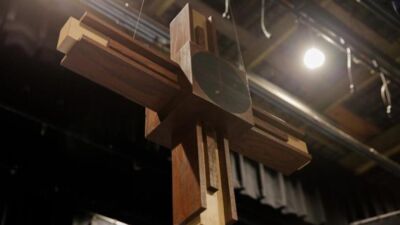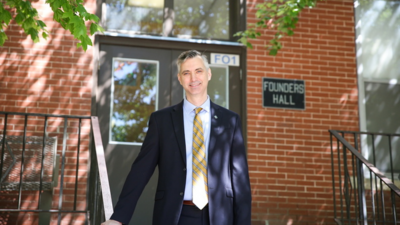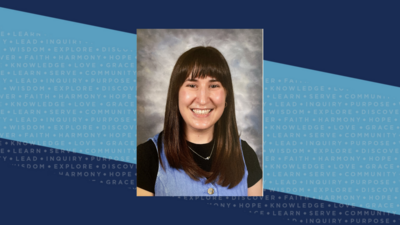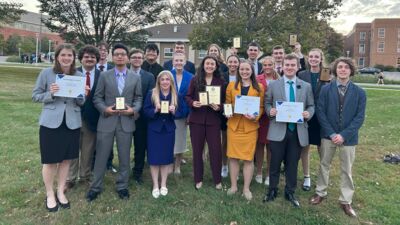Alumna Deb (Perschbacher) Jurchen ‘06 shares the story behind Weller Chapel’s two-sided hanging cross

Although you may not notice at first glance, the large, hanging cross in Concordia University, Nebraska’s Weller Chapel has a quite story to tell. When you look closely, you’ll begin to notice the beautiful artistry and rich symbolism of the piece. And the longer you look, the more you’ll see. The cross features an intricate, two-sided design and was crafted by alumna Deborah (Perschbacher) Jurchen ‘06 during her time on campus.
Jurchen now serves Concordia Nebraska as director of university institutes and is married to Rev. Dr. Pete Jurchen ’04, who is assistant professor of Lutheran education and faith formation at the university.
Deborah – who goes by Deb – has a bachelor of fine arts in art education and studio art with a minor in theology from Concordia Nebraska and a master of science in in family life education from Concordia University Wisconsin & Ann Arbor. She crafted the cross in 2006 during her senior year at Concordia Nebraska.
“I made the cross 20 years ago when the university’s Center for Liturgical Art was in its infancy,” she explained. “I came to Concordia Nebraska wanting to study art. I was very passionate about liturgical art and wanted to serve the church in some capacity. I added art education to my studies my sophomore year. Teaching art in the Lutheran schools around the country has allowed me to help students more clearly see the world around them and ultimately see the redemptive work of Christ. By adding education to my degree I not only had the joy of creating, but the joy of guiding students in a love of God’s gift of creativity.”
It was important to me to include a great depth of symbolism within the hanging cross. I wanted the viewer to be able to return time and time again and see the powerful redemptive work of our Lord and Savior, to have a resting spot for wandering eyes and minds that refocuses the viewer on Christ.
One of Deb’s first commissions in college was a freestanding altar for Messiah Lutheran Church in Lincoln. Always brainstorming and looking for new ways to create and add beauty, she then looked at the university’s chapel space and began wondering what could be added there.
“At that time the window curtains were drawn closed, with no stained glass in place. The chapel had an altar, but not much else,” she said. “There was a cross that would get moved all the time for anything that happened there, but I thought there should always be a cross in that space no matter what else was going on. I worked with the university president and the chaplain to come up with this two-sided cross – which features a main side and a Lent-focused side. It stayed in the campus chaplain’s office for a while, but eventually became the focal point of the space. I like to think it was a catalyst for the revitalization of the chapel space.”
More than just a beautiful, focal point piece, the creation of the cross was filled with symbolism and meaning.
“I knew I wanted to work with wood. I had done woodwork when I created the altar for the church in Lincoln. Wood is quick and easy to manipulate, and I thought it would be lighter for hanging,” she said. “It was important to me to include a great depth of symbolism within the hanging cross. I wanted the viewer to be able to return time and time again and see the powerful redemptive work of our Lord and Savior, to have a resting spot for wandering eyes and minds that refocuses the viewer on Christ.”
The cross is anchored with a center square or cube, which represents the four corners of the earth. The circle within the square reflects the eternal nature of God. On the Lent side of the cross features black markings to remind us of Christ coming into the world to take on the black of sin. Within that is a red cross, demonstrating that Christ took on the darkness of sin with His blood. The non-Lent side features burnt wood.
“This reflects a growth season,” she said. “There is death, but there is also a new life motif. The design looks a little agricultural as well. I wanted it to look like growth and new life in Christ. The main cross itself features both light and dark wood, and a cross shape breaks through that piece, representing the light of Christ breaking through the darkness. And on each cross beam, there are three sections, reinforcing the idea of the Trinity.”
Deb said she completed the creation of the cross with about three months of intense work. The cross was fashioned with an additional cross-shaped internal structure to prevent the piece from bowing and warping. She said it is an absolute delight to see something that she crafted during her time on campus as a student being enjoyed daily by many on campus. She said it’s definitely a full-circle moment.
“I started here as a student when the Center for Liturgical Art was in its infancy,” she said. “Now I get to come back and guide the center and the university’s other institutes into the future. Visual art is so important. God created us, we are visual people. What a gift to be able to create visual art that teaches congregations while aligning with our theological beliefs. The university’s Center for Liturgical art is heading in a new direction and seeks to build an association of artists from around the country who work in a variety of medias and in a variety of styles to serve the various needs within our church body. It’s an exciting time!”
The Jurchens have five children ages four to 15. When she’s not working, Deb enjoys spending time with her family, being active outdoors, hiking, gardening and kayaking.
“Prior to my current service at the university, I taught in Lutheran schools in every grade from preschool to grade 12, primarily as an art teacher,” she said. “As a mother and pastor’s wife, I see the great need for equipping families for lives of faith. Working at Concordia Nebraska is very fulfilling. I enjoy serving the Lord by filling needs within the church at large and helping support the workers in the kingdom!”
Concordia University, Nebraska’s Institutes provide outreach, service and educational efforts that align and advance the university’s mission and vision by engaging audiences beyond the campus while serving as a resource to the church at large.
Interested in Institutes at Concordia University, Nebraska?


